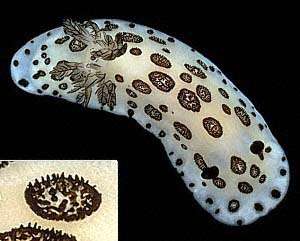
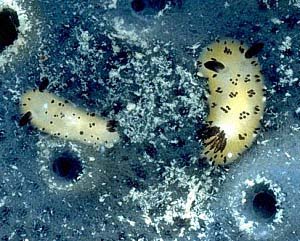
Jorunna funebris
(Kelaart, 1858)
Order: NUDIBRANCHIA
Suborder: DORIDINA
Family: Dorididae
DISTRIBUTION
Tropical Indo-West Pacific.
PHOTO
UPPER: Koumac, New Caledonia, October 1993. 54mm long alive. Inset showing papillate surface of dorsum caused by spiculate caryophyllidia all over the surface.
LOWER: Heron Is., Great Barrier Reef, Queensland, June 1983. Two juveniles (largest 7mm long) on apparent food sponge, Euplacella cf. australis [Haploscleridae: Callyspongiidae].
PHOTOS: Bill Rudman.
Reference:
• Kelaart, E.F. (1858). Description of new and little known species of Ceylon nudibranchiate molluscs and zoophytes. Journal of the Ceylon Branch of the Royal Asiatic Society,
Columbo, 3(1): 84-139.
Rudman, W.B., 1998 (December 31) Jorunna funebris (Kelaart, 1858). [In] Sea Slug Forum. Australian Museum, Sydney. Available from http://www.seaslugforum.net/find/jorufune
Related messages
Jorunna funebris from Western Australia
January 13, 2010
From: Glenn Teale
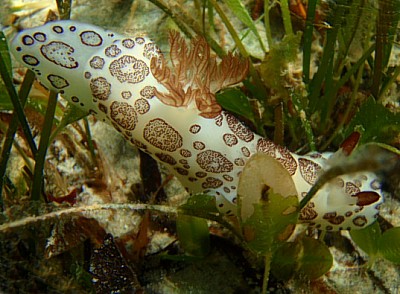
My first nudibranch sighting. It was photographed on the 2nd Jan after the blue moon at Horrocks Western Australia. The tide had dropped heaps, exposing the shallow reef creating large rock pools.
It was in one of these pools that I found the first Jorunna funebris. The second was about five meters away on the other side of the rock pool.
Locality: Horrocks, 1.2 m, Western Australia, Indian Ocean, 2 January 2010, Rock pool / reef - very low tide. Length: 70 - 90 mm. Photographer: Glenn Teale.
Glenn Teale
djskitza@shutteryourplace.com.au
Teale, G.J., 2010 (Jan 13) Jorunna funebris from Western Australia. [Message in] Sea Slug Forum. Australian Museum, Sydney. Available from http://www.seaslugforum.net/find/23085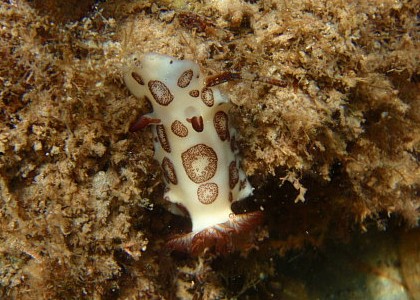
Thanks Glenn,
Best wishes,
Bill Rudman
Re: Jorunna funebris with egg mass
February 18, 2009
From: Milton Rosenau
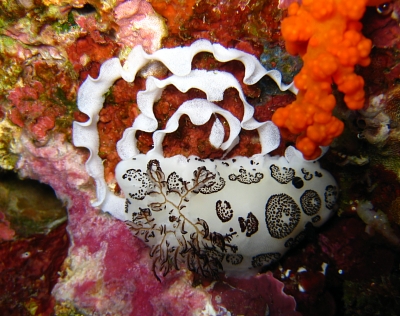
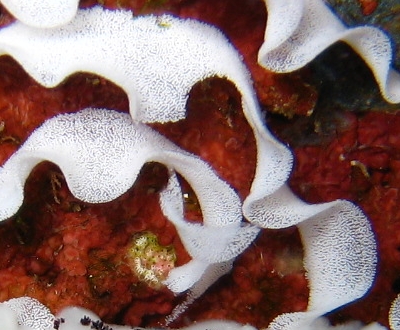
Concerning message #5940:
In case it is helpful, here are two photos of Jorunna funebris with a larger egg ribbon than shown in the 12 January 2002 message from Michael D. Miller.
Locality: Tanjung Burang, 60 feet, Banda Besar N.E. Point, Banda Sea, Indonesia, 25 November 2008. Length: 3 cm.. Photographer: Mickey Rosenau.
Milton D. Rosenau, Jr.
mdrosenau@gmail.com
Rosenau, M.D., 2009 (Feb 18) Re: Jorunna funebris with egg mass. [Message in] Sea Slug Forum. Australian Museum, Sydney. Available from http://www.seaslugforum.net/find/22251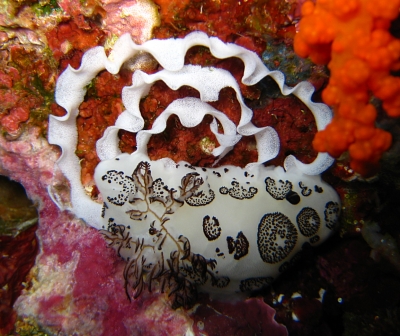
Dear Mickey,
Thanks for the photos. Size of egg ribbons varies with the size of the animal and whether this is the first egg ribbon it has produced in a season. An animal may lay a number of egg ribbons during its breeding season, and usually they become smaller as it gradually runs out of eggs, and I presume energy.
Best wishes,
Bill Rudman
Jorunna funebris on blue food sponge and eggs
February 18, 2009
From: Marcel Tanke
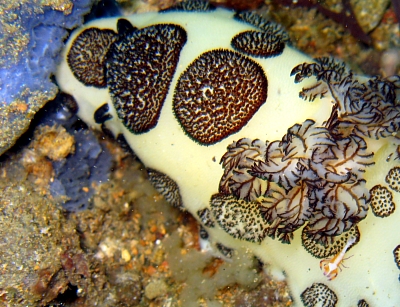
Concerning message #20664:
Dear Bill,
We found 6 Jorunna funebris. All quite large, up to about 12 cm and say 3 cm in diameter. In the upper picture, please note the small shrimp on its back and the feeding on the blue sponge.
In the bottom picture you can see it laying eggs. Several similar egg ribbons were in the same area.
Locality: Anilao, Secret Bay dive site, 10 meters, Philippines, 29 December 2008, 1 January 2009, sandy, flat bottom . Length: 12 cm. Photographer: Marcel Tanke.
Best regards,
Marcel
marceltanke@cs.com
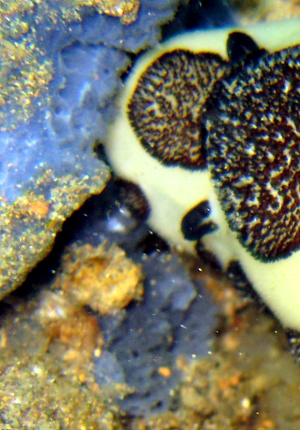
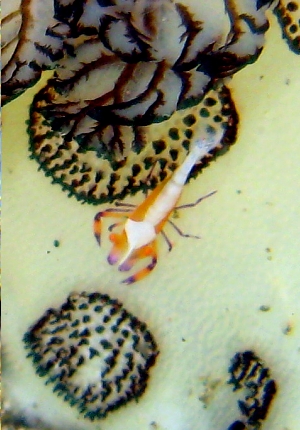
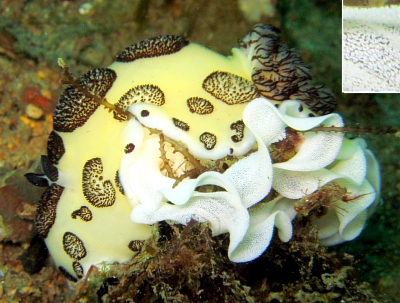
Dear Marcel,
Thannks for these photos. I have included a couple of close-ups of your upper photo to show feeding damage to the sponge colony and the shrimp, which is Periclimenes imperator. We used to think this shrimp was a commensal living only on Hexabranchus sanguineus, but over recent years it has been found on a wide variety of large sea slugs.
Best wishes,
Bill Rudman
Jorunna funebris from Vanuatu
May 6, 2008
From: Leanne and David Atkinson
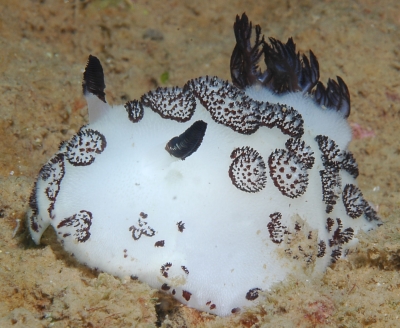
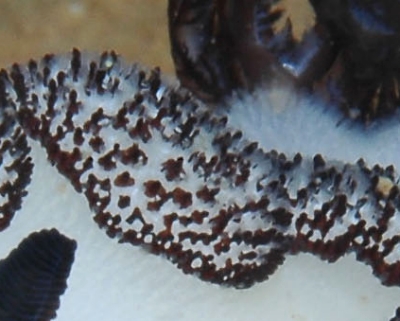
Concerning message #20664:
Dear Bill,
Here is Jorunna funebris from Vanuatu. You don't seem to have any examples of the animals from Vanuatu. We have seen them on both trips to Vanuatu in July 2007 and April 2008. The dive guide Joka that found this animal later commented that it was the biggest he had seen and he has been diving on Mele Reef for quite a long time. The water temperature was 29 degrees celcius. The animal is not where it was found the dive guide trying to be helpful picked it up and brought it to us a few metres away. Hope this is of interest.
Locality: Ghost Train, Mele Reef, 10 metres, Vanuatu, Pacific, 14 April 2008, Coral Reef close to shore low viz sandy and silty bottom between coral bommies. Length: 80mm approximately. Photographer: Leanne & David Atkinson.
Regards,
Leanne and David Atkinson
atk@hunterlink.net.au
Atkinson, L. & D., 2008 (May 6) Jorunna funebris from Vanuatu. [Message in] Sea Slug Forum. Australian Museum, Sydney. Available from http://www.seaslugforum.net/find/21560
Dear Leanne & David,
Thanks for the record. I've included a close-up to show hoe the back is covered in tubercules, each crowned with a ring of fine spicules. The colourless spicules are not easily seen but appear as a whtish blur in the background.
Best wishes,
Bill Rudman
Jorunna funebris on food sponge
April 29, 2008
From: Kenneth Yong
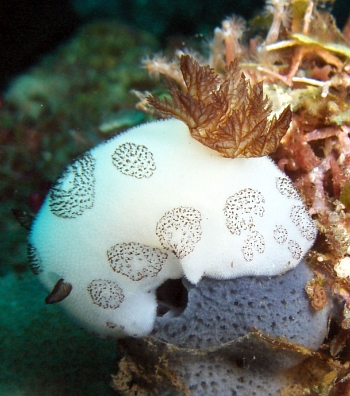
Dear Bill,
Here are 2 photos of Jorunna funebris feeding on a blue-gray sponge (the same species?), taken on 2 different dates at the same locality.
Locality: Tulamben, The Liberty Wreck, 8-10 m, Bali, Indonesia, Java Sea, 09 August [upper & centre left] and 11 August [lower and center right], 2006, On shipwreck. Length: 5-7 cm. Photographer: Kenneth Yong.
Hope they're of interest to you.
Thanks!
Cordially,
Kenneth
kyong67@tiscali.it
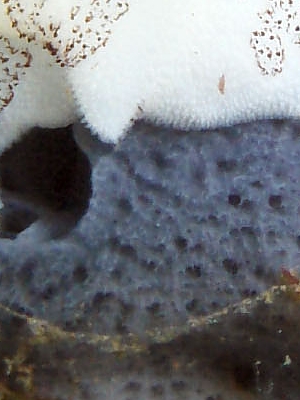
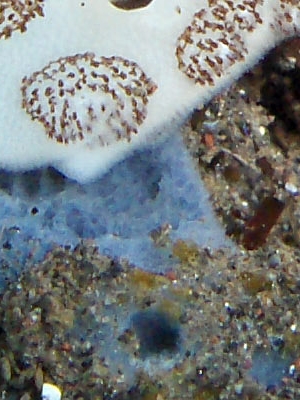
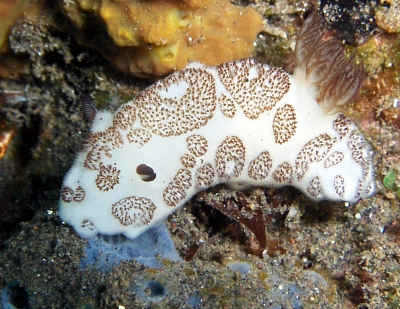
Dear Kenneth,
I am always keen to get 'activity' shots like this. I am sure these sponges are both the same species. At present I have two, or perhaps three, names for blue sponges which Jorunna funebris feeds on. I suspect they may be all the same species. Hopefully we can get a sponge expert familiar with his group of sponges to help.
Your photos show one of the difficulties in onserving nudibranchs feeding on sponges. In the lower phoyo ypou can see that much of the sponge colony has been hidden under a layer of sand and only that bit being eaten by the nudibranch has had the sand removed. The sponge in the upper photo shows how the sponge deals with the problems of being covered with sand. Ypu can see a string of mucus with sand grains entangled in it. To clean itself the sponge colony exudes a thin layer of sticky mucus which entangles the sand grains and lifts them off the colony. The mucus layer [+ sand grains] gradually breaks up and falls of the colony.
Best wishes,
Bill Rudman
Re: Food of Jorunna funebris
March 31, 2008
From: Samson Tan
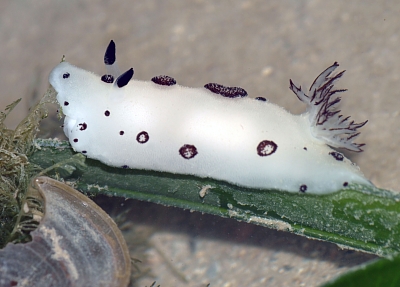
Concerning message #4279:
Hi Bill
I found this nudibranch yesterday during my inter-tidal walk at Semakau Island, south of Singapore. What puzzle me was the 'feeding habit' observed. It looks like this Jorunna funebris is feeding on the seaweed which is very unlikely. Have you came across any of such observations? I didn't find any blue sponges in the radious of 5 meters.
Locality: Semakau Island, south of Singapore, Inter-tidal area, Singapore, Singapore Straits, 21 March 2008, Inter-todal area at Seagrass lagoon. Photographer: Samson Tan.
Samson Tan
sos001y@yahoo.com
Tan, S., 2008 (Mar 31) Re: Food of Jorunna funebris. [Message in] Sea Slug Forum. Australian Museum, Sydney. Available from http://www.seaslugforum.net/find/21467Dear Samson,
Sea grass beds, even intertidal ones, have a surprisingly rich fauna, including many animals which attach themselves to the stalks of the plants living there. There are many small sponge colonies to be found there, and sometimes they grow to quite large sizes. If you find an apparently 'lost' sponge-feeder, like Jorunna, there are a number of possibilities. It could be an unfortunate animal that has become detached and washed away from its normal environment, but the more likely possibility is that it has been living and growing in the seagrass bed on a sponge colony which it may have now completely eaten. Another possibility is that there is a sponge colony there that you missed, perhaps it was on the underside of a rock?
It is definitely not a herbivore. Sponges can often be quite difficult to find. For many years I tried to find what was the food sponge of Rostanga arbutus, a common species around Sydney, without success. Finally I found it by taking a geological hammer to the rock platform and discovering a bright red sponge living only in the horizontal cracks in the sandstone rocks, quite invisible to normal search techniques. That is not an incitement for you to destroy your shore to find this blue sponge, just a warning that sometimes even a most common inhabitant can be easily missed.
Best wishes,
Bill Rudman
Young specimen of Jorunna funebris
February 12, 2008
From: Lawrence Neal
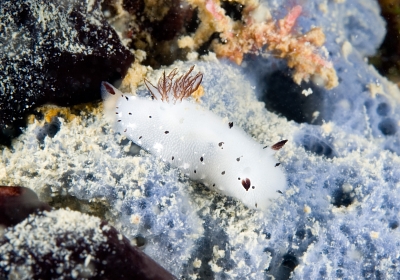
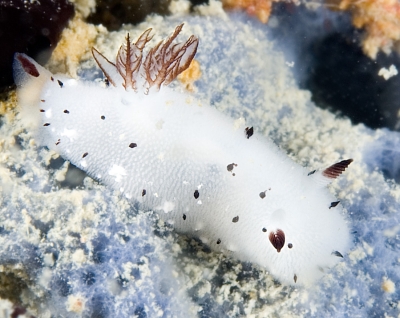
Dear Bill,
Thought you might be interested in this shot of Jorunna funebris.
In the Pattaya area of Thailand, J. funebris is one of the most common Nudibranchs. They can often be found on sponge encrusted rocks in the surge zone, usually less than 6 metres deep, and usually in association with the blue sponge.
This month (December - the coolest time of year here) I couldn't find any at all except for this tiny specimen less than 1 cm long. The spicules on this small animal are very clear.
Locality: Koh Rin, Chonburi, 6 metres, Thailand, Gulf of Thailand, 02 December 2007, Sponge and coral encrusted rocks in the surge zone. Length: 10 mm. Photographer: Lawrence Neal.
Best wishes,
Lawrence
lorenzo_n@yahoo.com
Neal, L., 2008 (Feb 12) Young specimen of Jorunna funebris. [Message in] Sea Slug Forum. Australian Museum, Sydney. Available from http://www.seaslugforum.net/find/21289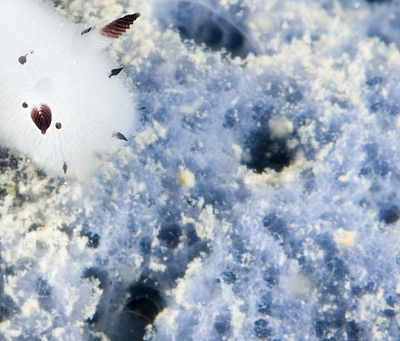
Dear Lawrence,
This looks very much like the photo I have on the Fact Sheet of two juveniles on their blue sponge. All I have to do now is get the sponge's identity sorted out. I had the blue sponge that the juveniles are on identified as Euplacella cf. australis [Fam: Callyspongiidae] but the blue sponge the adults are on has been identified as Xestospongia sp. [Fam: Petrosiidae]. I suppose they might change from one blue sponge to another as they grow but it would seem more likely that one of the identifications is wrong.
Best wishes,
Bill Rudman
Jorunna funebris from Reunion Island
June 12, 2007
From: Hugues Flodrops
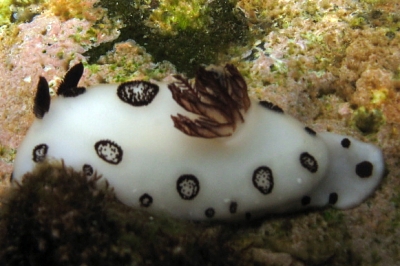
Dear Bill,
Here are three photos that I have determined is Jorunna funebris. I saw on the forum the confusion about the "blue sponge" that J. funebris feeds on. Here there is only some algae, I'm sorry.
Locality: Rocky coast Etang-Salé, 0,3 metres, Reunion Island, Indian Ocean, 16 january 2007. Length: 30 mm. Photographer: Hugues Flodrops.
Best regards.
Hugues
hugues.flodrops@wanadoo.fr
Flodrops,H., 2007 (Jun 12) Jorunna funebris from Reunion Island. [Message in] Sea Slug Forum. Australian Museum, Sydney. Available from http://www.seaslugforum.net/find/19248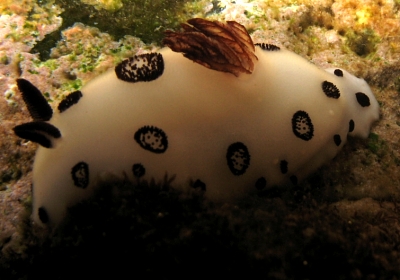
Dear Hugues,
Thanks for the record. We can't always be lucky and find them feeding
Best wishes,
Bill Rudman
Juvenile Jorunna funebris feeding
June 7, 2007
From: Bruce Wight
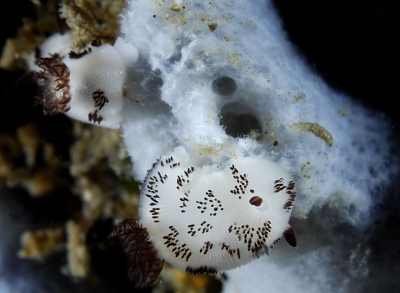
Dear Bill
Here is another feeding shot for the Forum
Locality: Lembeh Strait, 30-65 Feet, Sulawesi, Indonesia, Celebes Sea, November 2006, Found on reef and sand. Length: 3/8 to 5 inches. Photographer: Bruce Wight .
Bruce Wight
bruce.c.wight@boeing.com
Wight, B.C., 2007 (Jun 7) Juvenile Jorunna funebris feeding. [Message in] Sea Slug Forum. Australian Museum, Sydney. Available from http://www.seaslugforum.net/find/19944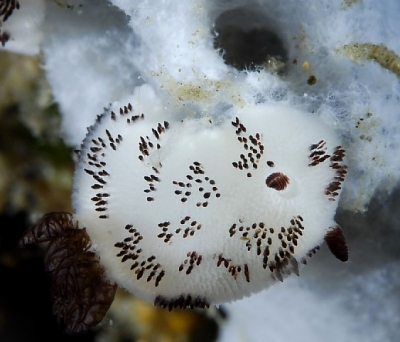
Thanks Bruce,
These are a pair of juvenile Jorunna funebris and they look to be on the same sponge as in the species Fact Sheet, which I had identified as Euplacella cf. australis.
Best wishes,
Bill Rudman
Jorunna funebris mating
April 4, 2007
From: Jim Anderson
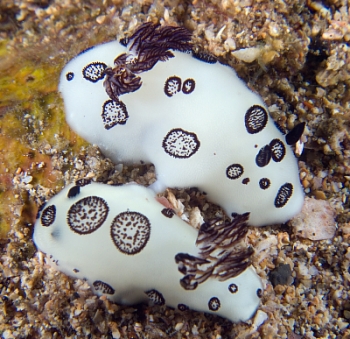
Hello again Bill,
Following a recent trip to Raja Ampat, Indonesia I am sending on some images that I trust will be of interest. Firstly an image of a pair Jorunna funebris 'happily' mating while the current runs.
Locality: Kabui Strait, 8 m, Raja Ampat, Indonesia, Dampier Strait, 5 March 07, current swept channel. Length: larger animal 25 mm. Photographer: Jim Anderson.
Kind regards,
Jim A
jander4454@gmail.com
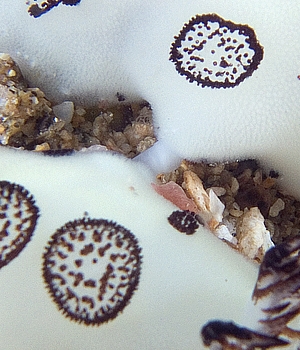
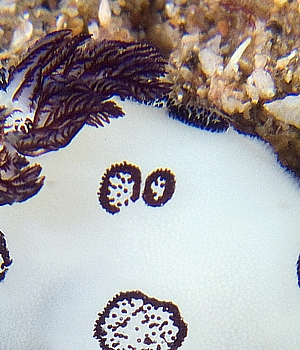
Thanks Jim,
I've included a couple of close-ups to show the mating and the characteristic bristles [caryophyllidia] all over the dorsum.
Best wishes,
Bill Rudman
Jorunna funebris hitch-hiking
April 4, 2007
From: Jim Anderson
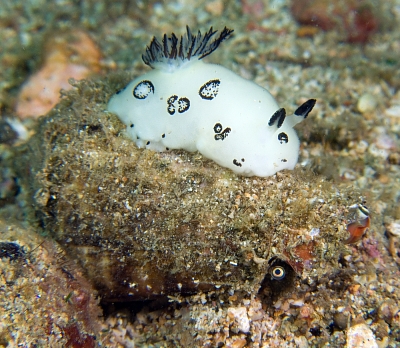
Hello again Bill,
Following a recent trip to Raja Ampat, Indonesia I am sending on some images that I trust will be of interest.
This Jorunna appears to be hitching a lift atop a cone shell. I am pretty sure he found his own way up here - there were no dive guides about!
Locality: Kabui Strait, 8 m, Raja Ampat, Indonesia, Dampier Strait, 5 March 07, current swept channel. Length: 20 mm. Photographer: Jim Anderson.
Regards,
Jim A
jander4454@gmail.com
Anderson, J., 2007 (Apr 4) Jorunna funebris hitch-hiking. [Message in] Sea Slug Forum. Australian Museum, Sydney. Available from http://www.seaslugforum.net/find/19785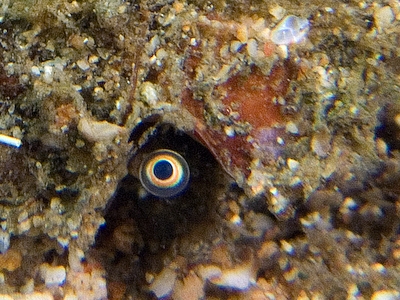
Thanks Jim,
When I read your message I thought a ride on a Cone Shell could be a bad career move for a slug, especially if the Cone Shell was a mollusc-eater like Conus textile. I am happy to be able to tell you that the snail is not a Cone Shell but a member of the Strombidae, probably a Strombus or Lambis. Their amazing stalked and colourful eyes, with the right one having its own notch in the shell, is characteristic. I have no idea how much they can see- if anything - but you certainly look like you are being watched when they are nearby.
Best wishes,
Bill Rudman
Jorunna funebris From Gulf of Kutch, Gujarat, India
July 28, 2006
From: Arpit Deomurari
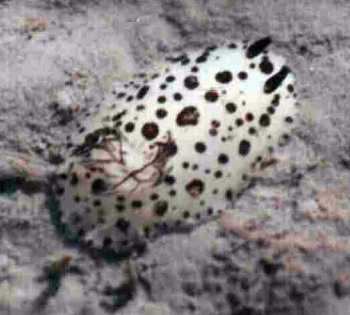
Concerning message #429:
I found this Jorunna funebris on the reef of Narara Islands in Gulf of Kutch, Gujarat, India.
This species was found frequently during my visit to most of the reef area in Gulf of Kutch. And some times in numbers of 25-40 in about 100 sq. mt. area.
Locality: Narara Island, 2 feet, Gujrat, Gulf of Kutch, Arabian Sea, 11 November 2005, intertidal. Photographer: Arpit Deomurari.
Arpit Deomurari
deomurari@gmail.com
Deomurari, Arpit, 2006 (Jul 28) Jorunna funebris From Gulf of Kutch, Gujarat, India. [Message in] Sea Slug Forum. Australian Museum, Sydney. Available from http://www.seaslugforum.net/find/17186Thanks Arpit,
I am interested to know it can occur so abundantly. Can you remember,or perhaps you have a photo of it in association with a blue sponge? If you look at other messages on this species you will find it seems to feed exclusively on a blue sponge. I found three juveniles of this species near Sikka, in the Gulf of Kutch, in 1971. My notes make no mention of them being on a sponge, but my memory is that it was extremely hot and my 'lab' was a tiny corner of a tin shed packed high with sacks of decaying chank snails [Xancus ]. It was hotter inside than out, and the smell was overpowering, so I have excused myself for poor notes.
Best wishes,
Bill Rudman
Jorunna funebris? from Indonesia
November 10, 2005
From: Bob Widman

My wife, Darlene took this picture in Komodo Indonesia. I believe this is Jorunna funebris, since I found a similiar one on your web site from South Africa [message #4860 ].
The brown patterns match up very closely. It also has a median brown band on the mantle
Locality: Komodo Is., Indonesia. Depth: 40 ft. Length: 1/2 inch. October 2003. Photographer: Darlene DeLancey
It was found in a sandy area.
Bob
bob@seashots.com
Widman, R., 2005 (Nov 10) Jorunna funebris? from Indonesia. [Message in] Sea Slug Forum. Australian Museum, Sydney. Available from http://www.seaslugforum.net/find/15212Dear Bob,
It is remarkably similar to the Sth African animal. All I can say is that I agree with what I said to Valda Fraser.
Best wishes,
Bill Rudman
Jorunna zania? from South Africa
November 7, 2005
From: Valda Fraser
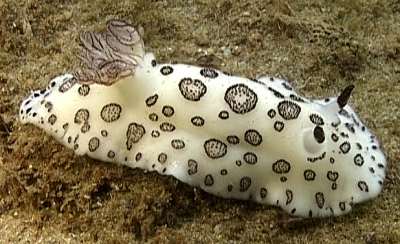
Dear Bill
Please confirm the ID of this as Jorunna zania I nearly squashed this one as it was on top of a rock in only a small drop of water.
Locality: Pumula, KwaZulu-Natal, South Africa. Indian Ocean coast. Intertidal zone. Length: 45 mm. March 2005. Intertidal. Photographer: Valda Fraser
Regards
Valda
valdafraser@mweb.co.za
Fraser, V.J., 2005 (Nov 7) Jorunna zania? from South Africa. [Message in] Sea Slug Forum. Australian Museum, Sydney. Available from http://www.seaslugforum.net/find/15065Dear Valda,
I am afraid I think the jury is still out on some of the species proposed by Eveline Marcus in her 1976 paper in which she revised this genus. However the two characters she used to differentiate J. zania from J. funebris are not visible in your photo, so I think it's best to leave it as J. funebris.
J. funebris: tips of oral tentacles black, penial papilla bulbiform
J. zania: tips of oral tentacles white, penial papilla minute
- Marcus, Ev. (1976) On Kentrodoris and Jorunna (Gastropoda Opisthobranchia). Boletim de Zoologia, Universidade de Sao Paulo, 1: 11-68.
Best wishes,
Bill Rudman
Juvenile Jorunna funebris from Great Barrier Reef
September 15, 2005
From: Sascha Schulz
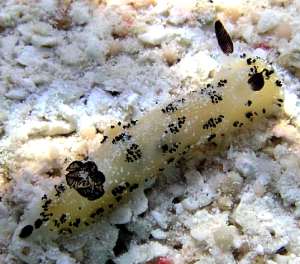
Dear Bill,
I have no idea what the little guy was doing out there as the nearest bommie was 20 m away. I suspect it may be a juvenile Chromodoris?
Heron Island, Great Barrier Reef, Queesnland, sand flats, 30 cm of water. November 2004
Sascha Schulz
ss31@dodo.com.au
Schulz, S., 2005 (Sep 15) Juvenile Jorunna funebris from Great Barrier Reef. [Message in] Sea Slug Forum. Australian Museum, Sydney. Available from http://www.seaslugforum.net/find/14756Dear Sascha,
This is a juvenile Jorunna funebris. I have a photo of a couple of juveniles like this on the species Fact Sheet
Best wishes,
Bill Rudman
Re: Jorunna funebris in aquarium
February 15, 2005
From: Roberto Sozzani
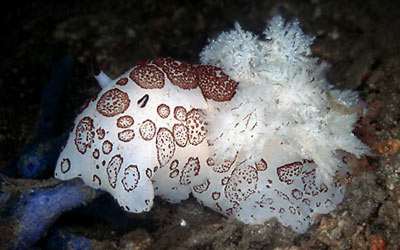
Dear Bill,
Thanks for your answer [message #13127 ].
I've several photos of Jorunna funebris, but I've seen them only once on blue sponges, like the huge one in this photo, in a very shallow and muddy area (Secret Bay - Bali), where a large number of individuals were mating. All other encounters were in clearer waters or healthy coral reefs. It's difficult to say if they were all in transit, but, as you said, it's only a guess. Next time I'll look carefully for blue sponges in the area!
Locality: Secret Bay (Nusantara II) - Bali, Indonesia. Depth: 5 metres, Length: 10 cm. March 2003. in muddy substrate. Photographer: Roberto Sozzani
Thanks again,
Roberto Sozzani
www.robertosozzani.it
roberto.sozzani@fastwebnet.it
Sozzani, R., 2005 (Feb 15) Re: Jorunna funebris in aquarium. [Message in] Sea Slug Forum. Australian Museum, Sydney. Available from http://www.seaslugforum.net/find/13152Re: Jorunna funebris in aquarium
February 12, 2005
From: Roberto Sozzani
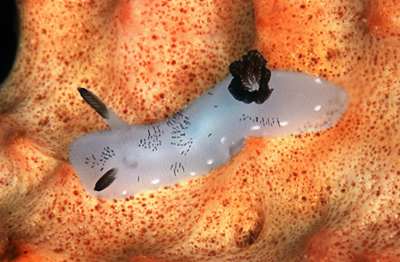
Dear Bill,
Concerning Cerdo Tserda's message [#12966], I've these 3 photos of juvenile Jorunna funebris in which we can see papillate mantle and few black spots. Two specimen are on the same sponge. All three show white spots on the mantle border.
Locality: Walea Island (East Sulawesi), Indonesia. Depth: 15 metres. Length: 15-20 mm.15 August 2004. Healthy coral slope. Photographer: Roberto Sozzani
Best wishes
Roberto Sozzani
www.robertosozzani.it
roberto.sozzani@fastwebnet.it
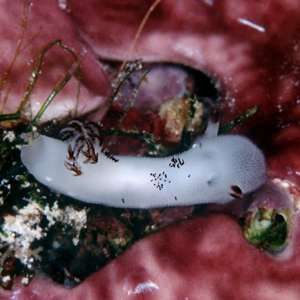

Thanks Roberto,
From all the messages on the Forum and photos published elsewhere, I had begun to feel that the blue sponge was this species' only food. I suspect the juveniles in your photos are just walking over these sponges - but that is just a hopeful guess on my part.
Best wishes,
Bill Rudman
Jorunna funebris in aquarium
February 9, 2005
From: Cerdo Tserda
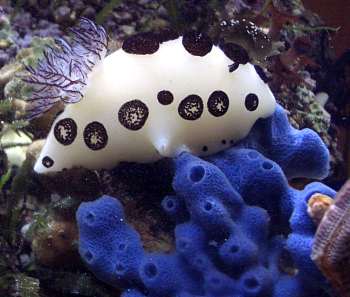
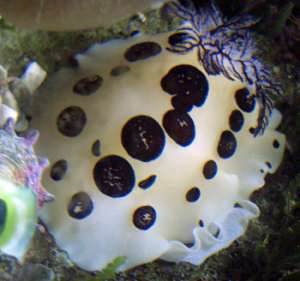
Dear Bill,
I am not into nudibranchs, but enjoy invertebrates in my small aquarium in my office. Today it is snowing outside and I need something warm and colorful! A few weeks ago I happened to find your wonderful website and, you won't believe it, a few days later I saw a Jorunna funebris in the nearby pet shop. A few aquaria further down, another coincidence, blue sponges for sale! It was really tempting... In the meantime, the Jorunna has eaten 3/4 of the sponge, and has laid eggs. [Length: 12 cm]. I will get more of the sponge from that shop [Welke, Lunen, Germany]. It's expensive, but they regularly get a piece or two. I am taking the bad ones, which look too ugly to sell.
What is known about breeding? Will the little ones be eaten by shrimp, hermite crab or small fish? Do the little ones look like the adult but smaller? Will they eat the same? Any information welcome.
Cerdo Tserda
a.manz@ic.ac.uk
Tserda, C., 2005 (Feb 9) Jorunna funebris in aquarium. [Message in] Sea Slug Forum. Australian Museum, Sydney. Available from http://www.seaslugforum.net/find/12966Dear Cerdo,
It's not often I hear a happy story about buying nudibranchs in aquarium shops. I don't think we know anything about the breeding cycle in this species but from the minute size of the eggs in the egg ribbon we can be fairly sure the larvae will be numerous, very small, and have a relatively long free-swimmimg period in the plankton [2 weeks to 2 months?] where they will have to feed on microscopic plants in the water. Keeping veliger larvae alive in aquarium conditions is very difficult. Two major problems is having the right algal phytoplankton in the water and preventing the larvae from becoming trapped in the surface layer of the water where they die.
So I don't hold our much hope for any hatching larvae, but they may be a nice food change for filter feeding animals in your aquarium
Best wishes,
Bill Rudman
Jorunna funebris from Malaysia
October 2, 2003
From: Asther M. Lau
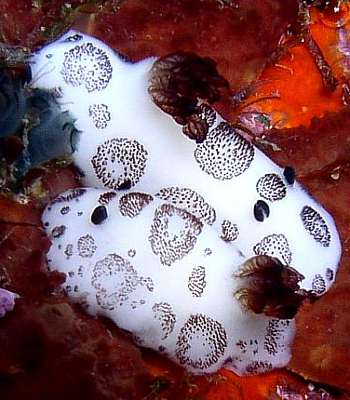
Dear Bill,
Here are some more pics of Jorunna funebris from one of my trips.
This pair was hanging on a wall of a channel tightly as current was so strong through the channel. They looked like they were in a mating position.
Site: Reniers Rock, Dayang Island, West Malaysia
Depth: 12 meter
Date: May 17th 2003
Taken by: Lim Eng Hoo
Regards,
Asther M. Lau
diveworldwide@yahoo.com
Lau, A.M., 2003 (Oct 2) Jorunna funebris from Malaysia. [Message in] Sea Slug Forum. Australian Museum, Sydney. Available from http://www.seaslugforum.net/find/11042Thanks Asther,
They certainly look as though they could be mating
Best wishes
Bill Rudman
Jorunna funebris from Malaysia
September 10, 2003
From: Asther M. Lau
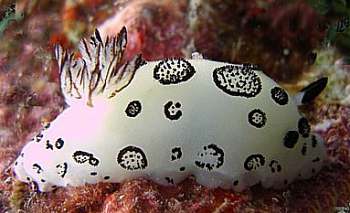
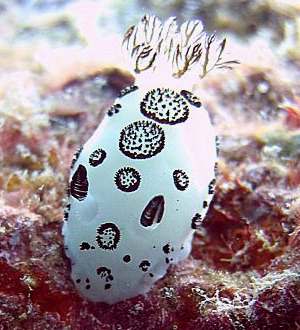
Dear Bill,
Came across this one which I think is Jorunna funebris. There were 2 of them (about 10cm distance frm each other.
Site: Tanjung Besi, Perhentian Is. Malaysia
Date: June 14th, 03
Depth: 10 meter
Size: Both averaging 2.5cm. When crawling, about 3.5cm
Asther M. Lau
diveworldwide@yahoo.com
Lau, A.M., 2003 (Sep 10) Jorunna funebris from Malaysia. [Message in] Sea Slug Forum. Australian Museum, Sydney. Available from http://www.seaslugforum.net/find/10913Dear Asther,
Yes this is Jorunna funebris.
Best wishes
Bill Rudman
Jorunna funebris at Sipadan.
December 7, 2002
From: Kheong Sann Chan
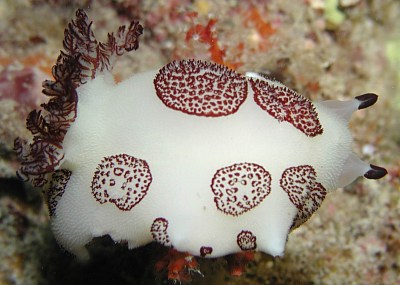
Dear Bill,
On a recent dive trip to Sipadan Island, [Sabah, Malaysia] we came across some Jorunna funebris (Hope I got the name right) on the night dives. On the first dive there was one climbing on the orange/pink sponge. On a later night dive we came across 2 similar such nudibranchs on a ledge.
Diving around Sipadan, you are more or less on a wall which drops off about 600m, not vertically down, but down. So these animals were found on ledges in the wall. The reef above goes out maybe 30m before a drop-off into the deep.
Location: Sipadan Island, Sabah, Malaysia. 25 Nov 2002. Depth: 10m. Size: about 10cm
Kheong.
kschan@mail.dsi.nus.edu.sg

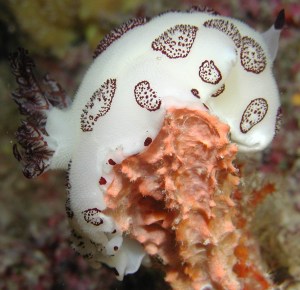
Dear Kheong,
Thanks for the photos. They show the spiculate tubercles [caryophyllidia] all over its mantle very clearly. I am surprised it is on an orange sponge as mostly it is found on a blue sponge. Either it has a wider food choice than we think or it was just passing by.
Best wishes,
Bill Rudman
Re: Algae as food
July 26, 2002
From: Edy Budiman
Samuel,
Concerning your message, I feed my Jorunna funebris with blue sponges from the genus Haliclona. I live in Jakarta, Indonesia and fortunately there are still a few LFS here that sell blue sponges for cheap prices (less than one dollar a piece).
Edy
edy_bd@yahoo.com
Budiman, E., 2002 (Jul 26) Re: Algae as food. [Message in] Sea Slug Forum. Australian Museum, Sydney. Available from http://www.seaslugforum.net/find/7650Thanks Edy,
Have a look at the earlier message where the identity of this blue sponge is discussed. There is a problem with collecting sponge ( and other) colonies for the aquarium trade, and that is that considerable damage is done to the environment in the collecting process. On top of this I can only assume that many of the colonies die before they reach the retailer, making the whole process incredibly damaging and wasteful.
Best wishes,
Bill Rudman
Algae as food
July 3, 2002
From: Samuel Yap
Hi Bill,
I hope you can assist me. I recently went to a local marine fish shop with the intention to purchase some snails so as to clean up the algae in my tank. But the guy at the shop told me that Jorunna funebris is able to perform the same task as a snail, ie: eat the algae. After I purchased the slug, I noticed for 3 days that it was not interested in eating up the algae and hence it prompted me to do a massive search for the details of this creature.
The person at the shop was not able to provide me the exact name of the creature but he told that it was a slug. I did a search and saw the same creature on the Forum. Reading through the Forum, I found out that Jorunna funebris actually feeds on blue sponge and nothing was said about feeding on algae. I don't have any form of sponge in my tank, and I am
concerned that it might die of starvation some day.
Appreciate your advise.
Regards,
Sam
Singapore
yaphcs@yahoo.com
Samuel, 2002 (Jul 3) Algae as food. [Message in] Sea Slug Forum. Australian Museum, Sydney. Available from http://www.seaslugforum.net/find/7415Dear Sam,
I am afraid your supplier either doesn't know what they are talking about or is tricking you. Have a look at the many messages I have posted on the Keeping sea slugs in captivity Page for my thoughts on keeping nudibranchs in aquaria. As you live in Singapore, it is possible that your supplier might by chance stock this sponge - but it would a lucky co-incidence as I doubt they or their collectors would have the knowledge to collect specific species of sponge. In Edy Budiman's recent message he says he recently bought some 'blue sponge'. I don't know where he lives but you may want to contact him for information.
As to alternative foods. Firstly, they don't eat plants. Secondly, I know of no 'generic' foods for nudibranchs. Over millions of years evolution has created the wonderfully diverse world in which we live. Part of that diversity is the very specialised feeding habits of each species of nudibranch. It is why you find Jorunna funebris on one sponge, Phyllidia ocellata on another etc., etc. I am afraid that nudibranchs are best left in the sea.
Best wishes,
Bill Rudman
Re: Jorunna funebris in aquarium
June 29, 2002
From: Edy Budiman
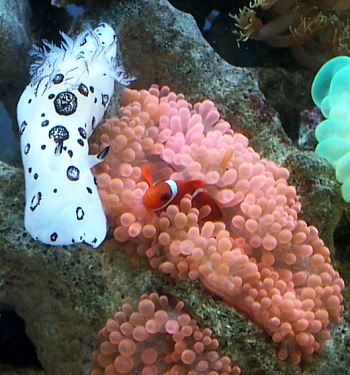
Dear Bill,
The Jorunna funebris nudibranchs I got a few weeks ago are still doing great. I attach a cool pic of it hanging over the rock while the maroon clown fish is watching from its rose anemone host.
Thanks,
Edy Budiman
webmaster@tropicalwares.com
Budiman, E., 2002 (Jun 29) Re: Jorunna funebris in aquarium. [Message in] Sea Slug Forum. Australian Museum, Sydney. Available from http://www.seaslugforum.net/find/7386Re: Jorunna funebris in aquaria
June 13, 2002
From: Edy Budiman
Thanks for the information. I've bought two pieces of blue sponges last week and since then the nudibranch (Jorunna funebris) would stick to the blue sponge most of the time eating it slowly. After its stomatch full, it wanders all over the aquarium. This nudibranch looks very cool and I hope by providing its proper food, I can keep it alive for as long as possible.
Edy Budiman
edy_bd@yahoo.com
Budiman, E., 2002 (Jun 13) Re: Jorunna funebris in aquaria. [Message in] Sea Slug Forum. Australian Museum, Sydney. Available from http://www.seaslugforum.net/find/7234Dear Edy,
It is good to hear a happy ending to stories about nudibranchs in aquaria. Hopefully your supplier can continue to provide the right blue sponge.
Best wishes,
Bill Rudman
Jorunna funebris in aquaria
June 10, 2002
From: Edy Budiman
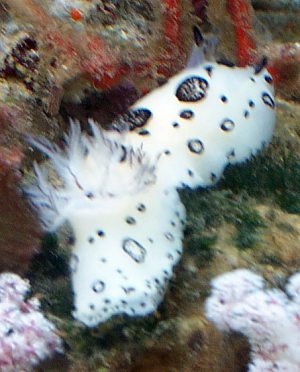
I have a Jorunna funebris nudibranch in my reef tank (85 gallon) and wondering if it's poisonous. Does it release toxin when stressed or died?
Does it particularly only eat blue sponges?
I'll do my best to keep it alive in my tank but I also don't want to take the risk of it poisoning my tank when it's dying.
Thanks in advance!
Edy Budiman
edy_bd@yahoo.com
Budiman, E., 2002 (Jun 10) Jorunna funebris in aquaria. [Message in] Sea Slug Forum. Australian Museum, Sydney. Available from http://www.seaslugforum.net/find/7175Dear Edy,
Phyllidiids are the most likely nudibranchs to secrete chemicals which are likely to kill animals in your tank. But if you obtain nudibranchs commercially, it is most likely that even phyllidiids have been so stressed during their journey to your tank, that they have secreted all their nasty chemicals.
I suspect your Jorunna will only eat its blue sponge. So I doubt it will poison your tank while it slowly dies of starvation, but as with other things that die in your aquaria - its best to remove them as soon as possible after death,
Best wishes,
Bill Rudman
Food of Jorunna funebris
April 5, 2002
From: Gustav Paulay
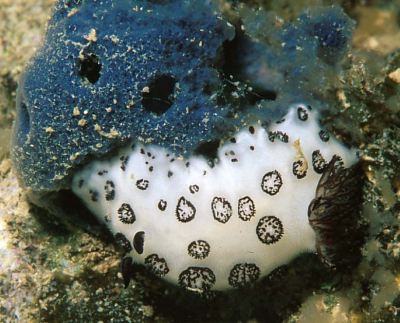
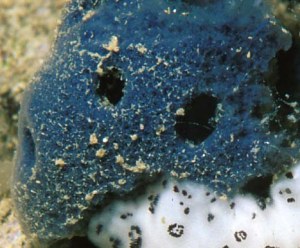
Dear Bill,
I was just looking at the Jorunna funebris entry on the Sea Slug Forum and noticed the confusion about its food sponge. We have just completed an inventory of the sponges of the Marianas (shortly to be out in Micronesica), and of course the “blue sponge” that J. funebris feeds on is on island (see photo). This sponge was initially identified by Michelle Kelly as a Haliclona, we then sent it to Rob van Soest, the world authority on Chalinidae. He was familiar with the species and called it the “blue aquarium Haliclona”, an undescribed species of Haliclona (Soestella). The sponge has a variable growth form and the photos on the Sea Slug Forum could potentially all belong to it. A characteristic of all species of Haliclona is that they have very soft, watery, easily compressible bodies, more so than most sponges. In contrast species of Xestospongia have a harder, often crumbly skeleton. A “feel test” in the field would let people check whether the sponge host they encounter is consistent with this ID, or whether potentially multiple sponge hosts are involved.
Cheers,
Gustav
paulay@flmnh.ufl.edu
Paulay, G. , 2002 (Apr 5) Food of Jorunna funebris. [Message in] Sea Slug Forum. Australian Museum, Sydney. Available from http://www.seaslugforum.net/find/6646Thanks Gustav,
Getting food identified is often difficult so any help is very welcome.
Best wishes,
Bill Rudman
Jorunna funebris from Bali
February 19, 2002
From: Stuart Hutchison
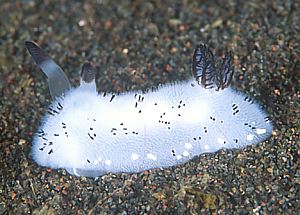
Bill,
Here's Jorunna funebris from Bali, Indonesia on 23 October 2001. Depth 15m, length 35mm.
Stuart
stuart@stuarthutchison.com.au
Hutchison, S., 2002 (Feb 19) Jorunna funebris from Bali. [Message in] Sea Slug Forum. Australian Museum, Sydney. Available from http://www.seaslugforum.net/find/6281Thanks Stuart,
From its high shape, and simple unbranched gills, it is definitely a juvenile.
Best wishes,
Bill Rudman
Jorunna funebris with egg mass
January 12, 2002
From: Michael D. Miller
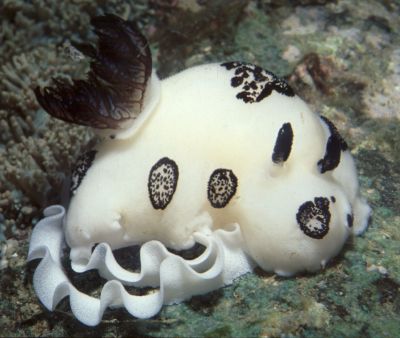
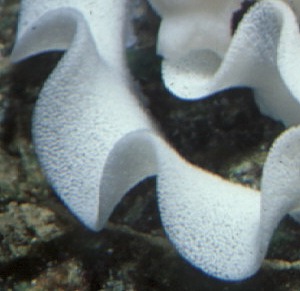
Dear Bill
Attached you will find an image of Jorunna funebris laying its egg mass. As with a previous submission (Hyselodoris bullockii), the animal seems to be securing the egg mass spiral to the subtrate with its foot.
Locale: Batangas, Philippines
Date: April, 1997
Photographer: Michael D. Miller
Cheers;
Mike Miller
mdmiller@cts.com
Miller, M. D. , 2002 (Jan 12) Jorunna funebris with egg mass. [Message in] Sea Slug Forum. Australian Museum, Sydney. Available from http://www.seaslugforum.net/find/5940Thanks Mike,
Yes the foot seems to be intinatley involved with fastening down the egg ribbon. In some species the egg ribbon appears to be extruded folded over lengthwise and in these animals the edge of the foot helps to unfold the ribbon as it is being fastened to the substrate.
Best wishes,
Bill Rudman
Jorunna cf. funebris from Sth Africa
August 7, 2001
From: Valda Fraser
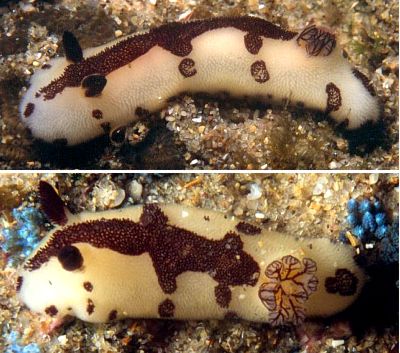
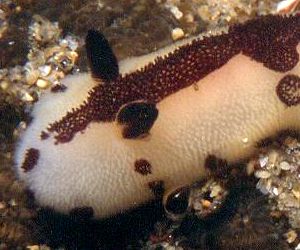
Dear Bill,
It is such a thrill to swim over a spot you know so well and to see a new visitor. Can you tell me who this is?
Locality: Pumula, south coast KwaZulu-Natal, SOUTH AFRICA, 18m
Date: July 2001
Size: 20mm
Valda Fraser
valdafraser@mweb.co.za
Fraser, V., 2001 (Aug 7) Jorunna cf. funebris from Sth Africa. [Message in] Sea Slug Forum. Australian Museum, Sydney. Available from http://www.seaslugforum.net/find/4860Dear Valda,
If you ignore the way the brown forms a median band on the mantle I would have no hesitation in saying that this was Jorunna funebris. But since I can't ignore the brown band what is it? I still think it is probably Jorunna funebris but think you should put it on your list of things worth looking out for. The east coast of South Africa is similar to the southeast coast of Australia in having tropical species which venture down into the warm temperate waters. In southeastern Australia we sometimes get quite strange colour forms of tropical species which I am reluctant to name as distinct species without further evidence that they are represent genetically distinct populations rather than something affected by the environment. It is possible that your animals represent a similar phenomenon. There is no guarantee that we would find distinct anatomical differences between these animals and J. funebris is we dissected one, but differences in egg ribbon and food might be useful indications. You might also find a brown striped one cohabiting with a spotted one. So at this stage I'll just call it Jorunna cf. funebris and wait for more evidence from the coalface.
Best wishes,
Bill Rudman.
Jorunna funebris? from the Seychelles
June 14, 2001
From: Erwin Köhler
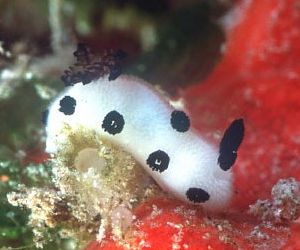
Dear Bill,
This one was made by Frank Gloystein (Frank.Gloystein@t-online.de) at the Seychelles, Bird Island on March 17, 2001, length about 1 cm, depth about 18 m.
Erwin
Erwin@medslugs.de
Köhler, E., 2001 (Jun 14) Jorunna funebris? from the Seychelles. [Message in] Sea Slug Forum. Australian Museum, Sydney. Available from http://www.seaslugforum.net/find/4567Dear Erwin,
This is almost certainly Jorunna funebris. You can see that two of the black spots are in fact open rings and as they grow the other apparent spots will also expand in size and become black rings. I suspect the red sponge? it is crawling over is just a footpath rather than a food source but I'm wiling to change my mind if I get a flood of photos of this species on a red sponge to match our collection of animals on the blue sponge.
best wishes,
Bill Rudman
Food of Jorunna funebris
May 9, 2001
From: Sylvain LE BRIS
Hi
Following my earlier message I just found another reference to the food of Jorunna funebris. This nudibranch can also eat the blue sponge Oceanapia sp. from India
Fontana A., Cavaliere P., Wahidulla S., Naik C. G. and Cimino G., 2000. A new antitumor isoquinoline alkaloid from the marine nudibranch Jorunna funebris. Tetrahedron, 56: 7305-7308
It seems that this nudibranch can eat many blue sponges. I know it is not the topic of this forum, but if anyone may help me to identify the blue sponge Xestospongia sp of the Gulf of Thailand or has some references...
Thank you
Sylvain
sylvain.lebris@freesbee.fr
Le Bris, S., 2001 (May 9) Food of Jorunna funebris. [Message in] Sea Slug Forum. Australian Museum, Sydney. Available from http://www.seaslugforum.net/find/4302Dear Sylvain,
There are a couple of references in my earlier comments on Mary Jane's message. The big question is whether the sponge taxonomy is correct. As I have said earlier, there are very few sponge taxonomists and sponge taxonomy is very difficult, often preserved specimens lacking most of the characters needed for identification. Many sponges can also take many growth forms and are often very variable in colour. I am sure your sponge expert is very good, but from my experience, even experts find it hard to agree. Until a genus or family of sponges is rigorously revised, using all available modern techniques, and relevant old type material examined, identification will be a major problem.
My advice is to keep samples of the sponges, preferably with photographs, and wait until the problems of sponge taxonomy and nomenclature improve. Waiting, of course, is a major problem from natural products chemists who discover a new molecule or compound and need to publish quickly.
Best wishes,
Bill Rudman
Food of Jorunna funebris
May 8, 2001
From: Sylvain LE BRIS
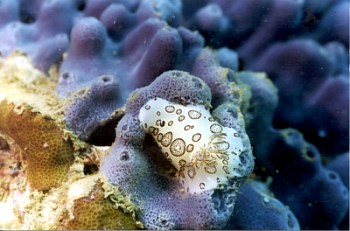
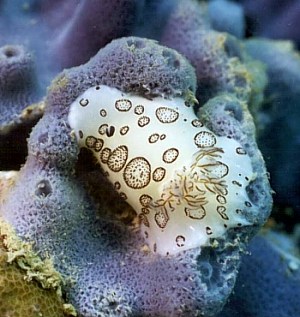
Hi Bill
This is a new picture of Jorunna funebris on a blue sponge. This picture was took in Sichang Is., in the Inner Gulf of Thailand last month, in 2 meter deep. I observed Jorunna funebris on this sponge in all the eastern Gulf of Thailand (Sichang Is., all the islands close to Pattaya, to Chang Is, close to the Cambodian border).
This blue sponge is Xestospongia sp. (identifed by 2 sponge specialists and confirmed by my microscopic obsevation of the spicules).
I wonder if there is a relation between the distribution of Jorunna funebris and the pollution. I observed 2 to 4 Jorunna funebris on each blue sponge in polluted locations whereas only 1 or 2 Jorunna on some blue sponge in non polluted area.
Regards
Sylvain
sylvain.lebris@freesbee.fr
Le Bris, S., 2001 (May 8) Food of Jorunna funebris. [Message in] Sea Slug Forum. Australian Museum, Sydney. Available from http://www.seaslugforum.net/find/4279Dear Sylvain,
Thanks for the photo and observations. This looks like one species we have a good idea about its food. I am a bit puzzled about the sponge identification I was given for the juveniles at the (Top of the page). I guess I should get the identification checked again.
Concerning pollution. It is very difficult to 'prove' the significance of observations such as yours without fairly exhaustive sampling and statistical analysis. Often the effects can be very subtle. Your observations are certainly worth mentioning, as they may fit with observations someone else has had, or even inspire a student or research worker to undertake a scientific investigation of your observations.
Best wishes,
Bill Rudman
Jorunna funebris on a blue sponge
March 24, 2001
From: Mary Jane Adams
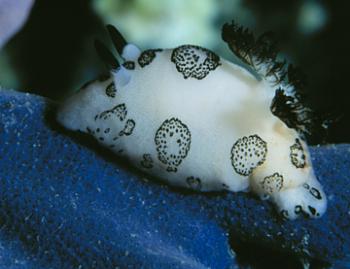
Hi Bill,
Here is another picture of Jorunna funebris on a blue sponge. It was sitting high off the reef on a long branch of the sponge. Milne Bay, Papua New Guinea, October, 1992.
Best regards,
Mary Jane
divepng@yahoo.com
Adams, M.J., 2001 (Mar 24) Jorunna funebris on a blue sponge. [Message in] Sea Slug Forum. Australian Museum, Sydney. Available from http://www.seaslugforum.net/find/4030Dear Mary Jane,
Thanks for another record. I think there is a case for assuming that either one, or a number of very similar-looking blue sponges is/are the preferred food of Jorunna funebris. A species of Xestospongia [see references below], has been identified as its food, but so has a similar blue sponge that I had identified as Euplacella cf. australis [Haploscleridae: Callyspongiidae]. I am afraid there are too many sponges and too few sponge taxonomists at present to solve all these food identification problems at the moment, but hopefully if we continue to collect data (and specimens where possible), some time in the future we will get the problems sorted out.
• Gulavita, N. K., Scheuer, P.J., & De Silva, E.D. (1991) Antimicrobial constituents of a sponge-nudibranch pair from Sri Lanka, pp. 229-233. In: Thompson, M.-F., Sarojini, R., & Nagabhushanam, R. (Eds.). Bioactive compounds from marine organisms with emphasis on the Indian Ocean. An Indo-United States Symposium xvii + 410 pp. Oxford & IBH Publishing Co., New Delhi.
• Kubo, A, Kitahara, Y. & Nakahara, S. (1989) Synthesis of new isoquinolinequinone metabolites of a marine sponge, Xestospongia sp., and the nudibranch Jorunna funebris. Chemical & Pharmaceutical Bulletin, 37(5): 1384-1386.
• Karuso, P. (1987) Chemical ecology of the nudibranchs, pp. 31-60. In: Scheuer, P.J. (Ed.), Bioorganic marine chemistry, vol. 1: vii + 185 pp. Springer-Verlag, Berlin.
Best wishes,
Bill
Jorunna funebris from Papua New Guinea
September 18, 2000
From: Stuart Hutchison
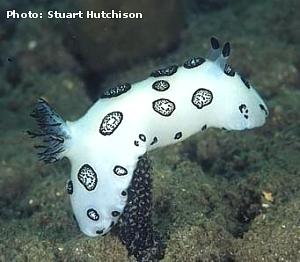
Dear Bill,
Here is a Jorunna funebris from Milne Bay, Papua New Guinea, March 1999. Found in about three meters of water very near a sulphur dioxide vent (the bubble bath), it was about two inches long and perched nicely for the photograph!
Stuart Hutchison
hutchco@tpg.com.au
Hutchison, S., 2000 (Sep 18) Jorunna funebris from Papua New Guinea. [Message in] Sea Slug Forum. Australian Museum, Sydney. Available from http://www.seaslugforum.net/find/2986Thanks Stuart,
Bill Rudman.
Jorunna funebris on sponge
August 28, 2000
From: Erwin Koehler
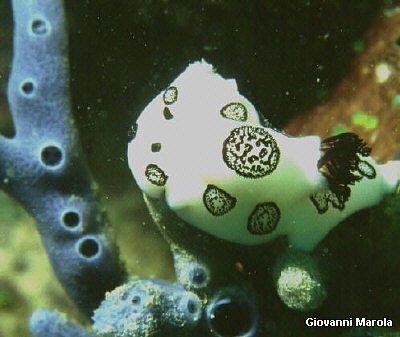
Dear Bill,
Here is one more photo of Jorunna funebris upon a blue sponge.
It was taken by Giovanni Marola
Email: marola@iet.unipi.it
Locality: Indonesia at Sangalaki Island, near to Kalimantan (Borneo). February 1999.
Size and depth were not recorded.
Erwin
Medslugs.Koehler@t-online.de
Koehler, E., 2000 (Aug 28) Jorunna funebris on sponge. [Message in] Sea Slug Forum. Australian Museum, Sydney. Available from http://www.seaslugforum.net/find/2938Dear Erwin,
Please thank Giovanni for the photo. We are certainly beginning to build up information suggesting that Jorunna funebris certainly likes this sponge, aparently to the exclusion of all others.
Best wishes,
Bill Rudman.
Confirmation of Jorunna funebris
January 29, 2000
From: David Freemantle
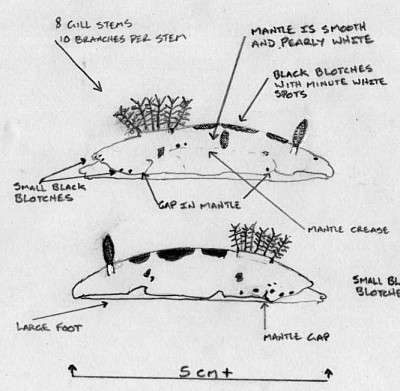

Dear Bill
I collected a what appears to be a Jorunna funebris the other day (a common species I know), and I just want to clarify the disimilarities between my animal and those illustrated in photo's I've seen of J. funebris. I can't distinguish the mantle and foot in all the photo's I've seen, and the animal I have is shaped very much like a Chromodoris, with pronounced foot and distinct mantle (see attached diagram), so without past experience with this animal I don't know if this is normal, so I thought it would pay to check.
By the way, the animal was found in 5 metres of water on a rock, 15 km south of Mandurah, Perth, Western Australia (exposed coastline).
Regards,
David Freemantle
scubadav@rock.upnaway.com
Freemantle, D., 2000 (Jan 29) Confirmation of Jorunna funebris. [Message in] Sea Slug Forum. Australian Museum, Sydney. Available from http://www.seaslugforum.net/find/1801Dear Dave,
Your sketches certainly look like Jorunna funebris. It's a bit hard to photograph many of the 'flat dorids' in a way that you can see them in profile. Have a look at the page on the dorid head. It has some pictures which give you a basic idea of the external shape of most of the Eudoridoidea (which I tend to think of as the 'Flat Dorids').
One point though is your mention in the top drawing of the mantle being 'smooth'. If it is Jorunna funebris the mantle should be covered in microscopic bristles as I've illustrated at the top of this page. Have a look below your message for further photos and discussion on this species. Have you seen your animals associated with any sponge?
Best wishes,
Bill Rudman.
Jorunna zania or J. funebris?
July 31, 1999
From: Ernest C.J. Seamark
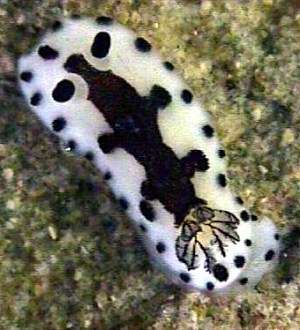
This individual is unlike the Jorunna zania that are common residents at Treasure Beach intertidal zone seen feeding on blue sponge. This individual was found on 13 August 1998.
Is Jorunna zania recognised in South Africa or is it Jorunna funebris?
[Treasure Beach is in Durban, KwaZulu Natal, South Africa.]
Ernest Seamark.
kearneyt@biology.und.ac.za
Seamark, E.C.J., 1999 (Jul 31) Jorunna zania or J. funebris?. [Message in] Sea Slug Forum. Australian Museum, Sydney. Available from http://www.seaslugforum.net/find/1050Dear Ernest,
I am afraid I have never been comfortable with some of the anatomical distinctions Marcus made in the 1976 paper. The photo of Jorunna zania Marcus, 1976, in Terry Gosliner's South African book looks identical to Jorunna funebris and your comment that it feeds on a blue sponge certainly suggests a close similarity with animals from the western Pacific.
The photograph you have sent is most probably a variation from the normal pattern you see in South Africa. However it's hard to be sure from a single photo, with no indication of size. perhaps you should look for more similarly coloured specimens and see if they diffre from 'normal' patterned animals in things like food sponge and shape and colour of egg ribbon.
Best wishes,
Bill Rudman.
Re: Jorunna zania from South Africa
July 31, 1999
From: Terry Gosliner
Dear Bill,
I share your concerns [in reply to Ernest Seamark's message] about the distinctness of Jorunna zania. I am fairly convinced that it is synonymous with Jorunna funebris. I believe Marcus differentiated the two species on the basis of the length of the spine in the vestibular gland of the reproductive system. This is something that should be looked at again, but I think it reasonable to assume that the two names are represented by the single species, J. funebris.
Terry
tgosline@calacademy.org
Gosliner, T.M., 1999 (Jul 31) Re: Jorunna zania from South Africa. [Message in] Sea Slug Forum. Australian Museum, Sydney. Available from http://www.seaslugforum.net/find/1141Jorunna funebris - feeding observations
June 19, 1999
From: Monica Sullivan
Dear Bill,
Hi there from the chilly west coast of Ireland. You may already have left for the nudibranch conference in Sicily. Wish I could be there...
I would like to have gone myself but am in the middle of setting up a wee ecological business here in Ireland and a girl has got to stay put for a while! I'm back from over a year in Indonesia where Lindsay was helping out on the science end of things (Operation Wallacea ). She has returned to the island and is continuing with the research for opisthos, flatworms etc. She has three new unknowns. Have you got them?
I took two Jorunna funebris and put them on a Haliclona sponge (which is presently in the Nat History in London undergoing spicule prep). I measured the sponge and nudi's and watched them devour the whole sponge over a two day period. Adam the underwater photographer took pics. I thought they would have been more interested in mating! Perhaps they were awaiting nightfall!!!
Take care, enjoy the conference,
All the best,
Monica
whirling@iol.ie
Sullivan, M., 1999 (Jun 19) Jorunna funebris - feeding observations. [Message in] Sea Slug Forum. Australian Museum, Sydney. Available from http://www.seaslugforum.net/find/953Dear Monica,
Your message arrived after I had left for Sicily. It was great to meet so many other slug people - my wife calls them 'slugfests' which is probably quite a good description.
Thanks for the Jorunna observations. I have posted your notes on Phyllodesmium longicirra and chelidonurids separately as it saves me from complicated cross-referencing.
Best wishes,
Bill Rudman.
Food of Jorunna funebris
February 22, 1999
From: Lindsay Warren
Dear Bill
Several weeks ago you posted a note about Jorunna funebris and what it feeds on. In the Tukang Besi Islands of SE
Sulawesi we have frequently found it on what appears to be the same sponge as shown in your photo on the Forum which we believe to be a species in the Order Haplosclerida.). We have also found it laying its eggs on the same sponge. On one occasion I found J. funebris on a large ascidian, Polycarpa aurata, but was unable to check if it was feeding or not as we were in the middle of hunting for a 'smoking' barrel sponge as well as checking the abundance of another sponge surveyed earlier in the day - very frustrating! Do you know if J. funebris feeds on large tunicates or is it exclusively a sponge feeder?
Many thanks for your help and look forward to hearing your comments on the above.
With best wishes
Lindsay Warren
100014.2112@compuserve.com
Warren, L., 1999 (Feb 22) Food of Jorunna funebris. [Message in] Sea Slug Forum. Australian Museum, Sydney. Available from http://www.seaslugforum.net/find/602Dear lindsay,
I have broken your message into sections so I can deal with the bits individually. Thanks for the observations on Jorunna funebris. It's unlikely that it eats ascidians as well as sponges. The morphology of its radular ribbon is typical of other sponge-feeding dorids.
Bill Rudman.
Rudman, W.B., 1999 (Feb 22). Comment on Food of Jorunna funebris by Lindsay Warren. [Message in] Sea Slug Forum. Australian Museum, Sydney. Available from http://www.seaslugforum.net/find/602nudibranch/anemone association
February 4, 1999
From: Keven Reed
On June 23, 1996 my scuba partner noticed a nudibranch on a beaded anemone, Heteractic aurora. The nudibranch was Jorunna funebris. Seeing the J. funebris/blue sponge photos on this web page, made me recollect and recheck my field notes.
Does anyone know of any significance to this observation? I did not notice any damage to either animal, and the nudibranch appeared healthy when I placed it in my home aquarium. I returned it to the ocean five days later, but could not relocate the H. aurora due to poor visibility. The site was Okinawa, Japan, dove from the shore at approx' 26 degrees 26' N, 127 degrees 46' E. Ocean temperature at scuba depth was 27C/81F.
Keven Reed
Hawaii
reedk001@hawaii.rr.com
Reed, K., 1999 (Feb 4) nudibranch/anemone association. [Message in] Sea Slug Forum. Australian Museum, Sydney. Available from http://www.seaslugforum.net/find/535
Dear Keven,
I suspect your Jorunna was just blundering through the beaded anemone colony. I don't know any nudibranchs that feed on beaded anemones. In New South Wales, however, Philippia lutea, an architectonicid snail, - which are now considered closely related to opisthobranchs - feeds on Corynactis. I've added a picture of it above.
Bill Rudman.
Food of Jorunna funebris
January 24, 1999
From: Michael Miller
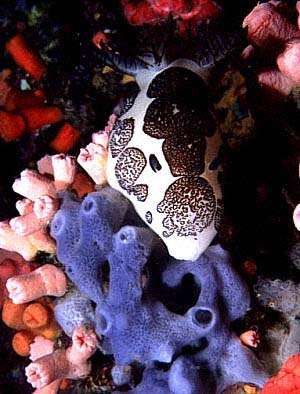
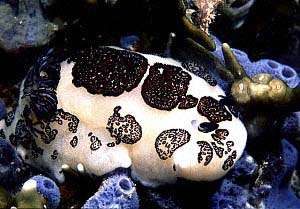
Dear Bill
Attached are two (2) pics of Jorunna funebris on the unknown blue sponge it seems to be particularly fond of. It is not uncommon to find J. funebris on the sponge in the Philippines. Any new developments as to the identity of the sponge??
Cheers;
Mike Miller
mdmiller@cts.com
Miller, M.D., 1999 (Jan 24) Food of Jorunna funebris. [Message in] Sea Slug Forum. Australian Museum, Sydney. Available from http://www.seaslugforum.net/find/509Dear Michael,
Thanks for the photos. I think this is a species of Callyspongia [Haplosclerida: Callyspongiidae] but without a specimen I think it will be difficult to get a confident identification from a sponge expert.. though I am trying. It is possible that it is the Euplacella I photographed the juveniles on [see photo at top of page - id by PR Bergquist], but even if it is not, both sponges seem to be closely related.
Bill Rudman.
Jorunna funebris with food sponge
December 31, 1998
From: Erwin Koehler
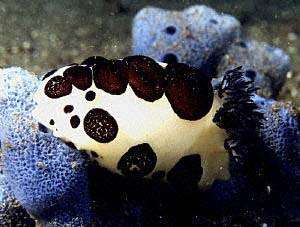
Dear Bill
Attached is a photo of Jorunna funebris feeding on a blue sponge. Negros Island, Philippines, size 5cm, depth 12m
Erwin
E.Koehler@deutschepost.de
Koehler, E., 1998 (Dec 31) Jorunna funebris with food sponge. [Message in] Sea Slug Forum. Australian Museum, Sydney. Available from http://www.seaslugforum.net/find/429Thanks Erwin,
Your photo reminded me of some small juveniles I photographed may years ago at Heron Island on a similar blue sponge [see photo at top of page]. Does anyone else have photos of Jorunna funebris on a possible food sponge? It would be nice to see how food specific it is.
Bill Rudman.
